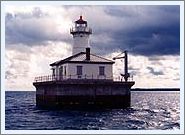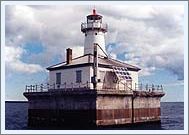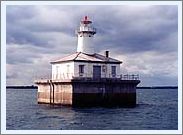|
Historical Information

With a scant fourteen feet of water above its hard gravel bottom,
Mariners recognized the hazard represented by this shoal lurking a mile
northwest of Cheboygan Point and close to the main course of entry into
Cheboygan Harbor, and while a second-class can buoy had long been placed
to mark this danger, it was plain that a more permanent solution was
needed.
In 1925, a construction crew was
working in the Straits at Martin
Reef, and plans had already been drawn
up for that same crew to transfer their base camp to Cheboygan at the
completion of the work at Martin Reef to begin construction of a
virtually identical structure at Poe
Reef. With the availability of such
an experienced crew in the area, the time was right to provide a more
permanent solution at Fourteen Foot Shoal, and plans were drawn up for a
new station on which construction would begin as soon as the work at Poe
Reef was completed. It was also determined that with the improved
lighting that would result from this new station, the seventy-five year
old Cheboygan Light would no longer be needed and could be discontinued
with the exhibition of the new light.
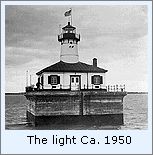 As a result of recent advances in
reliable radio control technology, it was also determined that the new
station could have its light and fog signal remotely controlled by the
keepers living at the planned Poe Reef Light Station, thereby
significantly lowering the cost of operating the new light. As a result of recent advances in
reliable radio control technology, it was also determined that the new
station could have its light and fog signal remotely controlled by the
keepers living at the planned Poe Reef Light Station, thereby
significantly lowering the cost of operating the new light.
As a temporary measure to better mark
the shoal, the can buoy marking Fourteen Foot Shoal was replaced by an
acetylene gas buoy showing a flashing white seventy candlepower light
every 3 seconds on April 15, 1925.
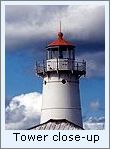 With
completion of the work at Poe Reef in 1929, the work crew turned their
attention to work at Fourteen Foot Shoal. While the new light was of a
totally different design, and considerably smaller than the twin lights
built at Martin and Poe Reefs, the construction of the crib proceeded in
much the same manner, with the construction of a wooden crib at the
shore station on the Cheboygan Pier. After an area on the shoal was
leveled, the crib was eased down wooden ways into the water, and towed
to the shoal by the Lighthouse Tender Aspen. Once over the leveled area,
the crib was sunk to the bottom by filling its empty pockets with rocks
and gravel. With
completion of the work at Poe Reef in 1929, the work crew turned their
attention to work at Fourteen Foot Shoal. While the new light was of a
totally different design, and considerably smaller than the twin lights
built at Martin and Poe Reefs, the construction of the crib proceeded in
much the same manner, with the construction of a wooden crib at the
shore station on the Cheboygan Pier. After an area on the shoal was
leveled, the crib was eased down wooden ways into the water, and towed
to the shoal by the Lighthouse Tender Aspen. Once over the leveled area,
the crib was sunk to the bottom by filling its empty pockets with rocks
and gravel.
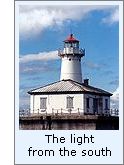 This timber foundation then served as a
core, upon and around which wooden forms were constructed and filled
with concrete loaded from the Lighthouse Service scow. As was the case
with both the Martin and Poe stations, the upper edge of the crib was
formed into a graceful flare, designed to deflect waves away from the
pier, in order to help protect the structures which would be erected on
the deck. With the completion of the concrete work, the pier stood fifty
feet square, and its deck level fifteen feet above the water. This timber foundation then served as a
core, upon and around which wooden forms were constructed and filled
with concrete loaded from the Lighthouse Service scow. As was the case
with both the Martin and Poe stations, the upper edge of the crib was
formed into a graceful flare, designed to deflect waves away from the
pier, in order to help protect the structures which would be erected on
the deck. With the completion of the concrete work, the pier stood fifty
feet square, and its deck level fifteen feet above the water.
The
steel framework for the single story equipment building was erected at
the center of the deck. Standing thirty-four feet by twenty-eight feet
in plan, on completion, the entire exterior of the building was sheathed
with 1/4-quarter inch steel plates, each riveted to the steel framework
beneath. Centered on the roof ridge, a cylindrical steel tower was
integrated into the roof, standing six feet in diameter and twenty-four
feet above the ridge line. The tower was capped with an octagonal cast
iron lantern and outfitted with a flashing white Fourth Order Fresnel
lens.
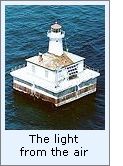 As
a result of its relative proximity to the shore, a submarine cable was
laid to the station, with power supplied by the Cheboygan municipal
power plant. As a result, the equipment building was outfitted with
electric motors to drive the compressors feeding the station's duplicate diaphone fog signals
sounding a characteristic one second blast followed by 14 seconds of
silence. The Fresnel lens was also illuminated with an 11,000
candlepower incandescent electric light bulb with a flashing mechanism
which provided a repeated three-second characteristic consisting of a
single flash of 1-second duration followed by a two-second eclipse. The
station's 50-foot focal plane provided the light with a range of
visibility of 14 miles in clear weather. To provide a light during the
winter months, a 130 candlepower acetylene powered 200 mm lens was also
installed in the lantern, fed by an acetylene tank located within the
main building. As
a result of its relative proximity to the shore, a submarine cable was
laid to the station, with power supplied by the Cheboygan municipal
power plant. As a result, the equipment building was outfitted with
electric motors to drive the compressors feeding the station's duplicate diaphone fog signals
sounding a characteristic one second blast followed by 14 seconds of
silence. The Fresnel lens was also illuminated with an 11,000
candlepower incandescent electric light bulb with a flashing mechanism
which provided a repeated three-second characteristic consisting of a
single flash of 1-second duration followed by a two-second eclipse. The
station's 50-foot focal plane provided the light with a range of
visibility of 14 miles in clear weather. To provide a light during the
winter months, a 130 candlepower acetylene powered 200 mm lens was also
installed in the lantern, fed by an acetylene tank located within the
main building.
The new Fourteen Foot Shoal Light was
exhibited for the first time at the opening of navigation in 1930, and
as planned, the old Cheboygan Light Station was discontinued at the same
time, and with the completion of the work, the construction crew moved
their base camp from the Cheboygan pier, and steamed up Lake Huron to
begin work on the new Detour
Reef Light.

Keepers of
this Light

This light was an an unmanned station
from its date of commissioning, with the equipment controlled and
maintained by the keepers at the Poe Reef Light, thus there were no keepers assigned
here. Click here to
see a complete listing of all Poe Reef Light keepers compiled by Phyllis
L. Tag of Great Lakes Lighthouse Research.

Finding this Light

While
a private vessel is undoubtedly the best way to obtain close-up views of
this Light, Sheplers Ferry Service out of Mackinaw City offers a number of lighthouse cruises during the summer
season, and their "Eastbound Tour" includes passes by Round Island, Bois Blanc Island, Poe Reef and Fourteen Foot Shoal. For schedules and rates for this tour, visit their website at:
www.sheplerswww.com or contact them at:
PO Box 250
Mackinaw City, MI 49701
Phone (800) 828-6157

Reference
Sources

USCG Historian's Office -
photographic archives.
Annual reports of the Lake Carriers Association, 1921-1930
Great Lakes Light Lists, 1939. 1953 & 1972
Great Lakes Coast Pilot, 1953, US Army Corps of Engineers.
Martin Reef - Lightship to Lighthouse, John J. Sellman
Photograph courtesy of Marge Beaver of Photography Plus.
Photograph courtesy of Julie Umlor
Keeper listings for this light appear courtesy of Tom & Phyllis Tag
|
